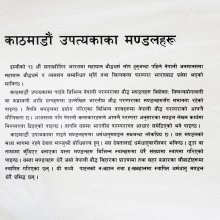Naha, Nāha: 12 definitions
Introduction:
Naha means something in Hinduism, Sanskrit, Buddhism, Pali, Jainism, Prakrit. If you want to know the exact meaning, history, etymology or English translation of this term then check out the descriptions on this page. Add your comment or reference to a book if you want to contribute to this summary article.
Images (photo gallery)
In Hinduism
Ayurveda (science of life)
Veterinary Medicine (The study and treatment of Animals)
Source: archive.org: The Elephant Lore of the HindusNāha (नाह) refers to the “girth” (of an elephant), according to the 15th century Mātaṅgalīlā composed by Nīlakaṇṭha in 263 Sanskrit verses, dealing with elephantology in ancient India, focusing on the science of management and treatment of elephants.—[Cf. chapter 6, “on determination of measurements”]: “2. The length of an elephant of the ‘deer’ caste just after birth is a hasta and a half, and he is said to be a kara (=hasta) high; his girth (nāha) is two hastas. And five aṅgulas is said to be their annual growth up to the tenth year”.

Āyurveda (आयुर्वेद, ayurveda) is a branch of Indian science dealing with medicine, herbalism, taxology, anatomy, surgery, alchemy and related topics. Traditional practice of Āyurveda in ancient India dates back to at least the first millenium BC. Literature is commonly written in Sanskrit using various poetic metres.
Languages of India and abroad
Pali-English dictionary
Source: BuddhaSasana: Concise Pali-English Dictionarynaha : (ind.) surely not.
Source: Sutta: The Pali Text Society's Pali-English DictionaryNāha, (nt.) (cp. nayhati, naddha) armour J. I, 358 (sabba°sannaddha). Cp. onāha. (Page 351)

Pali is the language of the Tipiṭaka, which is the sacred canon of Theravāda Buddhism and contains much of the Buddha’s speech. Closeley related to Sanskrit, both languages are used interchangeably between religions.
Sanskrit dictionary
Source: DDSA: The practical Sanskrit-English dictionaryNāha (नाह).—[nah bhāve ghañ]
1) Binding, confinement.
2) A trap or snare.
3) Costiveness, constipation.
Derivable forms: nāhaḥ (नाहः).
Source: Cologne Digital Sanskrit Dictionaries: Shabda-Sagara Sanskrit-English DictionaryNāha (नाह).—m.
(-haḥ) 1. Binding, confinement. 2. A trap, a snare for catching deer, &c. 3. Obstruction in any organ or secretion of the body, as costiveness, &c. E. ṇah to bind, affix bhāve ghañ .
Source: Cologne Digital Sanskrit Dictionaries: Benfey Sanskrit-English DictionaryNāha (नाह).—i. e. nah + a, m. Obstruction, [Suśruta] 2, 369, 5.
Source: Cologne Digital Sanskrit Dictionaries: Monier-Williams Sanskrit-English Dictionary1) Nāha (नाह):—m. (√nah) binding, tying, [cf. Lexicographers, esp. such as amarasiṃha, halāyudha, hemacandra, etc.]
2) obstruction (cf. nāsā-n)
3) trap or snare for catching deer, [cf. Lexicographers, esp. such as amarasiṃha, halāyudha, hemacandra, etc.]
Source: Cologne Digital Sanskrit Dictionaries: Yates Sanskrit-English Dictionary1) Naha (नह):—(ya, lau, ña) nahyati, te 1. c. To bind.
2) Nāha (नाह):—(haḥ) 1. m. Binding; a trap for deer; constipation.
[Sanskrit to German]
Sanskrit, also spelled संस्कृतम् (saṃskṛtam), is an ancient language of India commonly seen as the grandmother of the Indo-European language family (even English!). Closely allied with Prakrit and Pali, Sanskrit is more exhaustive in both grammar and terms and has the most extensive collection of literature in the world, greatly surpassing its sister-languages Greek and Latin.
Prakrit-English dictionary
Source: DDSA: Paia-sadda-mahannavo; a comprehensive Prakrit Hindi dictionary1) Nāha (नाह) in the Prakrit language is related to the Sanskrit word: Nātha.
2) Ṇaha (णह) also relates to the Sanskrit word: Nabhas.
3) Ṇāha (णाह) also relates to the Sanskrit word: Nātha.
4) Nāha (नाह) also relates to the Sanskrit word: Nātha.
Prakrit is an ancient language closely associated with both Pali and Sanskrit. Jain literature is often composed in this language or sub-dialects, such as the Agamas and their commentaries which are written in Ardhamagadhi and Maharashtri Prakrit. The earliest extant texts can be dated to as early as the 4th century BCE although core portions might be older.
Kannada-English dictionary
Source: Alar: Kannada-English corpusNāha (ನಾಹ):—
1) [noun] a binding or being bound.
2) [noun] an obstruction; an impediment; a trap.
Kannada is a Dravidian language (as opposed to the Indo-European language family) mainly spoken in the southwestern region of India.
See also (Relevant definitions)
Starts with (+24): Nahaba, Nahabi, Nahada, Nahadanem, Nahak, Nahaka, Nahala, Nahalai, Nahalana, Nahalavana, Nahalu, Nahalya, Naham, Nahamin, Nahamsi, Nahana, Nahanacunna, Nahanagaruka, Nahanaghara, Nahanakala.
Query error!
Full-text (+89): Parinaha, Upanaha, Anaha, Unnaha, Vinaha, Nasanaha, Drunaha, Pratinaha, Avanaha, Pranaha, Ninaha, Naham, Natha, Unaha, Nahas, Nahanavali, Parinahin, Sarthanatha, Naha-kanoko-so, Nahani.
Relevant text
Search found 69 books and stories containing Naha, Nāha, Ṇaha, Ṇāha; (plurals include: Nahas, Nāhas, Ṇahas, Ṇāhas). You can also click to the full overview containing English textual excerpts. Below are direct links for the most relevant articles:
Vivekachudamani (by Shankara)
Rig Veda (translation and commentary) (by H. H. Wilson)
Bhagavad-gita (with Vaishnava commentaries) (by Narayana Gosvami)
Verse 7.25 < [Chapter 7 - Vijñāna-Yoga (Yoga through Realization of Transcendental Knowledge)]
Verse 18.26 < [Chapter 18 - Mokṣa-yoga (the Yoga of Liberation)]
Verse 11.53 < [Chapter 11 - Viśvarūpa-darśana-yoga (beholding the Lord’s Universal Form)]
Chandogya Upanishad (english Translation) (by Swami Lokeswarananda)
Vinaya (2): The Mahavagga (by T. W. Rhys Davids)
Mahavagga, Khandaka 6, Chapter 36 < [Khandaka 6 - On Medicaments]
Notices of Sanskrit Manuscripts (by Rajendralala Mitra)
